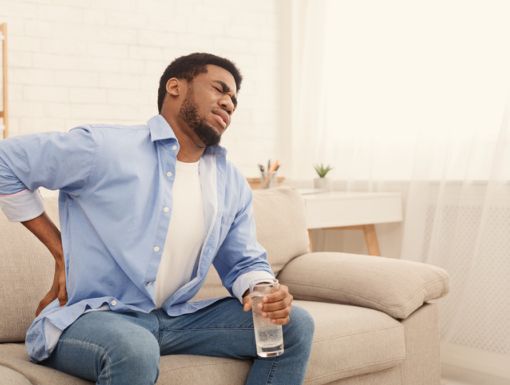
Adult Scoliosis Symptoms and Management: 4 Things You Should Know
Scoliosis is a condition in which the spine curves in three dimensions. While it’s most often diagnosed in children, adults can also develop it. If left untreated, a curved spine in adulthood can cause discomfort, posture changes, and mobility challenges.
Adult scoliosis usually develops due to uneven wear and tear on the discs in your spine, called asymmetric disc degeneration. This can lead to degenerative scoliosis. Another cause is scoliosis from childhood that wasn’t treated and has continued to worsen over time.
What are the symptoms of scoliosis in adults?
It’s important to know the signs and symptoms of scoliosis to catch it early and get the proper treatment. Here are the common symptoms adults may have:
- Back pain: Can range from dull aches to sharp pain, especially after standing or walking.
- Posture changes: You might notice uneven shoulders, hips or leaning forward or sideways when you walk.
- Tightness or cramping: Some people feel cramping or tightness in their legs or buttocks, especially while walking.
- Difficulty walking: Scoliosis can make you feel unbalanced, which might slow down your steps or tire you out faster.
- Stiffness: The curve in your spine may make bending or twisting harder than usual.
How serious is scoliosis in adults?
Scoliosis in adults can cause significant challenges if not managed correctly. Many people adjust their posture to ease back pain, often leaning forward when they walk. While this may help temporarily, it can strain your back muscles over time and worsen your pain.
Adult scoliosis can also narrow the space in your spinal canal, a condition called spinal stenosis. This puts pressure on nerves and can make walking more painful and difficult. Early diagnosis can help reduce symptoms and improve your quality of life.
Who is at risk for adult scoliosis?
Adult scoliosis can affect anyone, but certain factors can increase your chances of developing it. These include:
- Previous spine surgery: People who have had lumbar spine procedures, particularly those with Harrington rods, are more likely to develop scoliosis.
- Family history: If close family members have had back problems or needed spinal surgery, you may have a higher risk.
What hurts when you have scoliosis?
Adults with scoliosis often experience symptoms that interrupt daily life. These may include:
- Back pain while standing or walking
- A feeling of falling forward or leaning to one side
- Tightness or cramping in the legs or buttocks
- Persistent aches and sharp pain with prolonged movement
These symptoms can slowly worsen if scoliosis is left untreated, making it harder to enjoy daily activities.
Are there exercises for adults with scoliosis?
Exercise can help manage scoliosis symptoms by improving posture, flexibility, and core strength. Here are some beginner-friendly exercises you can try:
- Cat-cow stretch - This stretch increases spine flexibility. Get on your hands and knees, arch your back upward like a cat, then slowly drop your belly and lift your head and chest. Repeat 8–10 times.
- Pelvic tilt - Lie on your back with your knees bent and feet on the floor. Tighten your stomach muscles to press your lower back flat against the ground, then release. Do 10–15 reps to strengthen core muscles.
- Plank - Hold a forearm plank to build core stability. Start by holding the position for 10–15 seconds and work your way up as you get stronger.
- Wall angels - Stand with your back against a wall, keeping your spine straight. Slowly raise your arms upward, mimicking the motion of a snow angel. This helps improve posture. Perform 10 reps.
- Side stretch - Stand tall with your feet shoulder-width apart. Raise one arm overhead and lean to the opposite side for a gentle stretch. Switch sides and repeat.
Always check with a doctor or physical therapist before starting a new exercise program to ensure it’s safe for your condition.
How can you fix scoliosis as an adult?
The treatment for adult scoliosis varies, depending on the severity of your symptoms. Most doctors first recommend non-surgical approaches, including:
- Medication - Over-the-counter or prescription anti-inflammatory drugs can help reduce pain and swelling.
- Physical therapy - Therapists can guide you through exercises that strengthen the muscles around your spine, improve posture and increase flexibility.
- Epidural steroid injections - These injections target nerve pain by reducing inflammation in specific spine areas.
- Scoliosis bracing - A supportive brace may relieve pain, but adults usually wear it for short periods, like 30 minutes to an hour.
If these treatments don’t help and scoliosis continues to affect your daily life, surgery might be an option. Surgery for adult scoliosis straightens the spine but has a long recovery time and is usually only recommended for serious cases.
Living with scoliosis as an adult may take some adjustments, but there are many ways to manage your symptoms and stay active. Exercise, medication, and physical therapy can make a big difference in reducing pain and improving how you move. If you have scoliosis or are experiencing back issues, contacting your doctor is a great first step. Addressing it early can help you find treatments that work best for you and keep you feeling your best.



